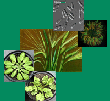| Clemens, S; Ma, JF: Toxic Heavy Metal and Metalloid Accumulation in Crop Plants and Foods, Annu. Rev. Plant Biol. (2016), doi:10.1146/annurev-arplant-043015-112301 | |
| Abstract: Arsenic, cadmium, lead, and mercury are toxic elements that are almost ubiquitously present at low levels in the environment because of anthropogenic influences. Dietary intake of plant-derived food represents a major fraction of potentially health-threatening human exposure, especially to arsenic and cadmium. In the interest of better food safety, it is important to reduce toxic element accumulation in crops. A molecular understanding of the pathways responsible for this accumulation can enable the development of crop varieties with strongly reduced concentrations of toxic elements in their edible parts. Such understanding is rapidly progressing for arsenic and cadmium but is in its infancy for lead and mercury. Basic discoveries have been made in Arabidopsis, rice, and other models, and most advances in crops have been made in rice. Proteins mediating the uptake of arsenic and cadmium have been identified, and the speciation and biotransformations of arsenic are now understood. Factors controlling the efficiency of root-to-shoot translocation and the partitioning of toxic elements through the rice node have also been identified. |

